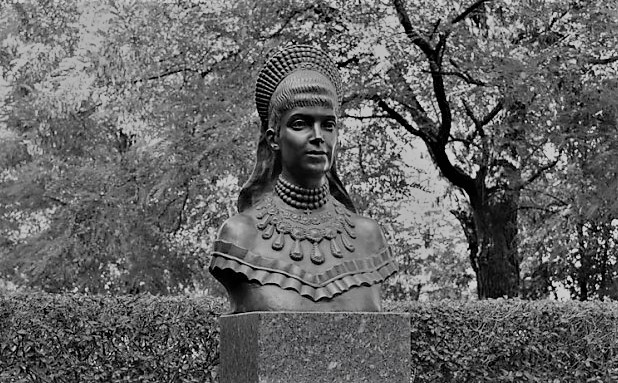Monuments
Statues, monuments, memorials and gravestones all have great personal, symbolic, honorary and/or political importance. They are also artistic expressions and artworks both in private and in public. They are primarily used as mementos, embellishments and statements. Due to the importance and family relations of the Danish princess Dagmar, some monuments of Danish-Russian historic interest are to be found in Denmark. The historic relations of the two countries goes far back: Commercial trade, political alliances, dynastic marriages and exchanges of gifts. And a great mutual cultural influence in art, literature and music. (Top illustration: Royal attendance for the inauguration of the monument for King Christian (IX) and Queen Louise, 1913. In the middle: Dowager Empress Maria Feodorovna. © KB/Royal Library, Creative Commons)

Inaugurating the comemorative monument for their majesties King Christian (IX) and Queen Louise, 1913. Present are both the Danish King Christian X and Queen Alexandra, Duchess Thyra and the Dowager Empress Maria Feodorovna. © KB/Royal Library, Creative Commons

Portrait-bust of Empress Maria Feodorovna. Bronze cast after the original bust in marble made by Russian artist Mark Matveyevich Antokolsky (1843-1902). The original marble bust from 1887 was already placed at the Hermitage, Winter Palace before 1917. This portrait ornates the entrance courtyard at The Russian Church in Bredgade in Copenhagen

Portrait statue of Maria Feodorovna in white marble, ordered in 1884 by Danish art-lover and patron Carl Jacobsen. The life-size statue was sculpted by French artist Jean Gautherin and delivered in 1889. Its pendant, a statue of her sister Queen Alexandra, was delivered in 1891. A special room was designed and decorated to house the two pendant statues, the so-called Empress´ Hall. The room and the statues were finally revealed at a reception honouring the Golden Wedding Anniversary of their parents in 1892. The statue is still in situ at The Empress Hall

September 19th 2013, a new statue of Maria Feodorovna was officially inaugurated, honouring the 400th anniversary of the Romanov Dynasty. The portrait is a bronze cast and was created by Russian artist living i Copenhagen, Sergey Boguslavsky

Bronze cast of the original bust of Emperor Alexander III by artist Alexander Bock, dating from 1898. The original bust was placed on the main staircase of the Mikhailovsky Palace at the time of the opening of the Russian Museum of Emperor Alexander III. This portrait was set on a large pedestal in the gardens at Fredensborg, next to the Emperors private villa, in 1915.

Pyotr Ilyich Tchaikovsky (1840 –1893) was the first Russian composer whose music made a lasting impression internationally. He actually appeared as a guest conductor in Europe and the United States. In 1884, Alexander III conferred upon him the Order of St. Vladimir, which included a title of hereditary nobility. In 1893, University of Cambridge in England awarded Tchaikovsky an honorary Doctor of Music degree. This modern interpretation of Tchaikovsky was given as a present to The Royal Theatre in Copenhagen in march 2018, marking the 80th anniversary of the first performance of Swanlake on the Danish stage, and is sculpted by Russian artist Alexander Rozhnikov

Fyodor Dostoyevsky (1821 – 1881) is a Russian novelist and short-story writer whose psychological penetration enters into the darkest recesses of the human heart. Dostoyevsky is regarded as one of the finest novelists who ever lived. He visited the Assistens Cemetery in Copenhagen in 1865. The Dostoyesvky monument was given as a present in 2019 for outstanding theater performances based on Dotoyevskys work staged in the former Chapel since 2013, and is sculpted by Russian artist Andrey Tartishnikov
